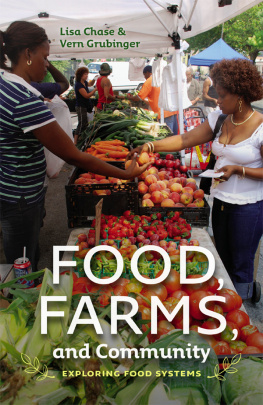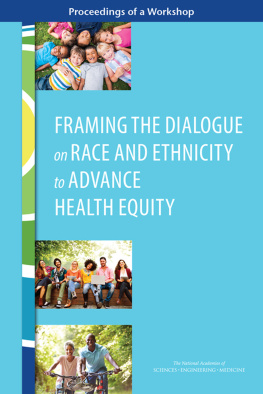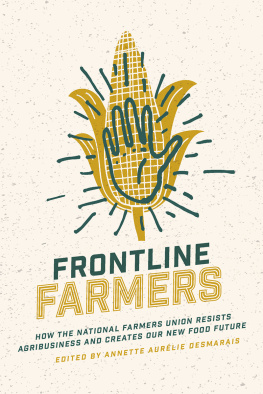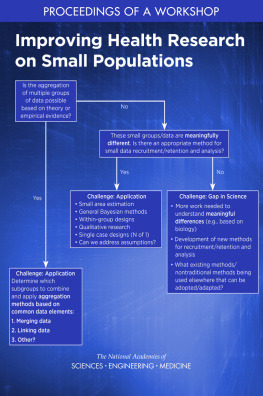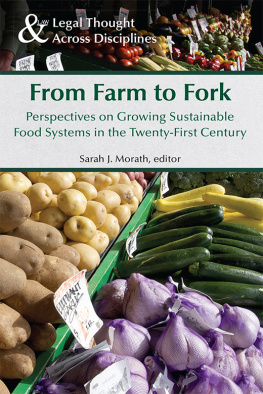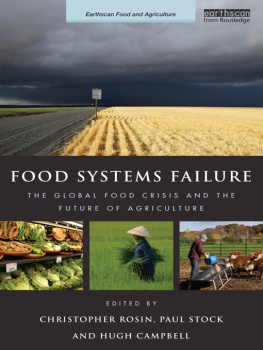Aguilar, J., G. G. Gramig, J. R. Hendrickson, D. W. Archer, F. Forcella, and M. A. Liebig. 2015. Crop species diversity changes in the United States: 19782012. PLOS ONE 10(8):e0136580.
Akhundjanov, S. B., R. K. Gallardo, J. J. McCluskey, and B. J. Rickard. 2020. Commercialization of a demand-enhancing innovation: The release of a new apple variety by a public university. Economic Modelling 86:88100.
Arnold, R. D., and J. P. Wade. 2015. A definition of systems thinking: A systems approach. Procedia Computer Science 44:669678.
Atallah, S. S., M. I. Gmez, and T. Bjrkman. 2014. Localization effects for a fresh vegetable product supply chain: Broccoli in the eastern United States. Food Policy 49:151159.
Baker, G. A., L. C. Gray, M. J. Harwood, T. J. Osland, and J. B. C. Tooley. 2019. On-farm food loss in northern and central California: Results of field survey measurements. Resources, Conservation and Recycling 149:541549.
Barth, M., K. Boriboonsomsin, and G. Wu. 2014. Vehicle automation and its potential impacts on energy and emissions. In Road vehicle automation, edited by G. Meyer and S. Beiker. Cham, Switzerland: Springer International Publishing. Pp. 103112.
Bastide, N. M., F. H. F. Pierre, and D. E. Corpet. 2011. Heme iron from meat and risk of colorectal cancer: A meta-analysis and a review of the mechanisms involved. Cancer Prevention Research 4(2):177.
Bauman, A., D. Thilmany McFadden, and B. B. R. Jablonski. 2018. The financial performance implications of differential marketing strategies: Exploring farms that pursue local markets as a core competitive advantage. Agricultural and Resource Economics Review 47(3):477504.
Belasco, W. 2006. Meals to come: A history of the future of food, California studies in food and culture. Berkeley and Los Angeles, CA: University of California Press.
Bigelow, D. P., and A. Borchers. 2017. Major uses of land in the United States, 2012. Washington, DC: U.S. Department of Agriculture, Economic Research Service.
BLS (Bureau of Labor Statistics). 2018. Heavy and tractor-trailer truck drivers. https://www.bls.gov/ooh/transportation-and-material-moving/heavy-and-tractor-trailer-truck-drivers.htm (accessed October 28, 2019).
BLS. 2019. Employment by industry, seasonally adjusted. https://www.bls.gov/charts/employment-situation/employment-levels-by-industry.htm (accessed December 9, 2019).
Boyer, D., and A. Ramaswami. 2017. What is the contribution of city-scale actions to the overall food systems environmental impacts?: Assessing water, greenhouse gas, and land impacts of future urban food scenarios. Environmental Science & Technology 51(20):1203512045.
Brandt, P., A. Ernst, F. Gralla, C. Luederitz, D. J. Lang, J. Newig, F. Reinert, D. J. Abson, and H. von Wehrden. 2013. A review of transdisciplinary research in sustainability science. Ecological Economics 92:115.
Canning, P., S. Rehkamp, A. Waters, and H. Etemadnia. 2017. The role of fossil fuels in the U.S. food system and the American diet. Washington, DC: U.S. Department of Agriculture, Economic Research Service.
Capper, J. L., R. A. Cady, and D. E. Bauman. 2009. The environmental impact of dairy production: 1944 compared with 2007. Journal of Animal Science 87:21602167.
Choi, C., and S. McFetridge. 2019. Ugly produce trend may have limits, as grocers end tests. https://apnews.com/9f020310dbff41fd919367f81ceb27c6 (accessed December 9, 2019).
Consumer Reports. 2018. Foods produced using animal cell culture technology: 2018 nationally representative phone survey. https://advocacy.consumerreports.org/wpcontent/uploads/2018/08/2018-CR-SURVEY-REPORT-ON-FOODS-PRODUCEDUSING-ANIMAL-CELL-CULTURE-TECHNOLOGY-1.pdf (accessed October 28, 2019).
Deller, S. C. 2014. Strategies for rural wealth creation: A progression of thinking through ideas and concepts. In Rural wealth creation, edited by J. L. Pender, B. A. Weber, T. G. Johnson, and J. Matthew Fannin. New York: Routledge.
Dimitri, C., L. Oberholtzer, and A. Pressman. 2016. Urban agriculture: Connecting producers with consumers. British Food Journal 118(3):603617.
Ellison, B., B. R. L. Duff, Z. Wang, and T. B. White. 2016. Putting the organic label in context: Examining the interactions between the organic label, product type, and retail outlet. Food Quality and Preference 49:140150.
Ellison, B., K. Brooks, and T. Mieno. 2017. Which livestock production claims matter most to consumers? Agriculture and Human Values 34(4):819831.
EPA (U.S. Environmental Protection Agency). 2017. Food recovery hierarchy. https://www.epa.gov/sustainable-management-food/food-recovery-hierarchy (accessed October 28, 2019).
FAO (Food and Agriculture Organization of the United Nations). 2011. Global food losses and food wasteextent, causes and prevention. Rome, Italy: Food and Agriculture Organization.
FAO, IFAD (International Fund for Agricultural Development), UNICEF (United Nations Childrens Fund), WFP (United Nations World Food Programme), and WHO (World Health Organization). 2019. The state of food security and nutrition in the world 2019: Safeguarding against economic slowdowns and downturns. Rome, Italy: Food and Agriculture Organization.
Fernandez-Cornejo, J. 2004. The seed industry in U.S. agriculture: An exploration of data and information on crop seed markets, regulation, industry structure, and research and development. Washington, DC: U.S. Department of Agriculture, Economic Research Service.
Fraser, R. Z., M. Shitut, P. Agrawal, O. Mendes, and S. Klapholz. 2018. Safety evaluation of soy leghemoglobin protein preparation derived from Pichia pastoris, intended for use as a flavor catalyst in plant-based meat. International Journal of Toxicology 37(3):241262.
Gallagher, L., A. Hsu-Flanders, and N. L. W. Wilson. 2019. From gleaning to for-profits: Efforts to mitigate food loss and feed people. In The economics of food loss in the produce industry, edited by T. Minor, S. Thornsbury, and A. K. Mishra. New York: Routledge.
Goerner, S. J., B. Lietaer, and R. E. Ulanowicz. 2009. Quantifying economic sustainability: Implications for free-enterprise theory, policy and practice. Ecological Economics 69(1):7681.
Gpel, M. 2016. The great mindshift. Berlin, Germany: Springer International Publishing.
Grenzeback, L. R., A. Brown, M. J. Fischer, N. Hutson, C. R. Lamm, Y. L. Pei, L. Vimmerstedt, A. D. Vyas, and J. J. Winebrake. 2013. Freight transportation demand: Energy-efficient scenarios for a low-carbon future. Washington, DC: U.S. Department of Energy.
Guerrero Campanur, A., E. Olivares-Benitez, P. A. Miranda, R. E. Perez-Loaiza, and J. H. Ablanedo-Rosas. 2018. Design of a logistics nonlinear system for a complex, multiechelon, supply chain network with uncertain demands. Complexity 2018:16.
Gunders, D. 2012. Wasted: How America is losing up to 40 percent of its food from farm to fork to landfill. https://www.nrdc.org/sites/default/files/wasted-food-IP.pdf (accessed December 9, 2019).
Gunter, A., and D. Thilmany. 2012. Economic implications of farm to school for a rural Colorado community. Rural Connections, Winter 1316.
Hall, K. D., A. Ayuketah, R. Brychta, H. Cai, T. Cassimatis, K. Y. Chen, S. T. Chung, E. Costa, A. Courville, V. Darcey, L. A. Fletcher, C. G. Forde, A. M. Gharib, J. Guo, R. Howard, P. V. Joseph, S. McGehee, R. Ouwerkerk, K. Raisinger, I. Rozga, M. Stagliano, M. Walter, P. J. Walter, S. Yang, and M. Zhou. 2019. Ultra-processed diets cause excess calorie intake and weight gain: An inpatient randomized controlled trial of ad libitum food intake. Cell Metabolism 30(1):6777.
Heller, M., and G. Keoleian, A. 2018.



